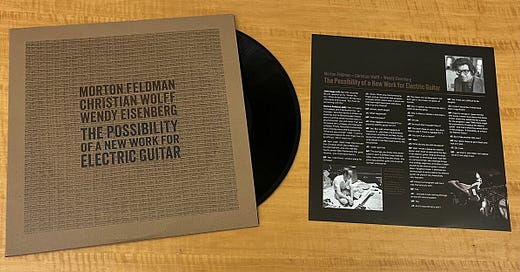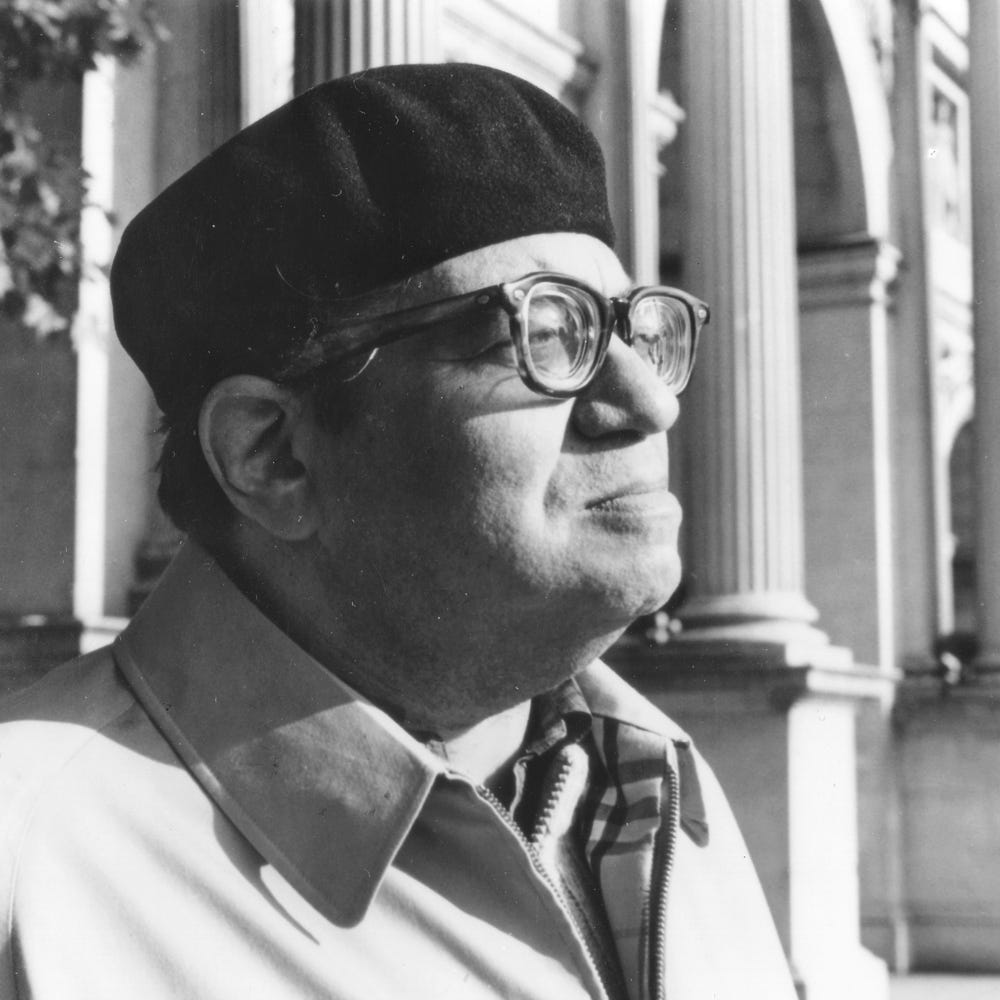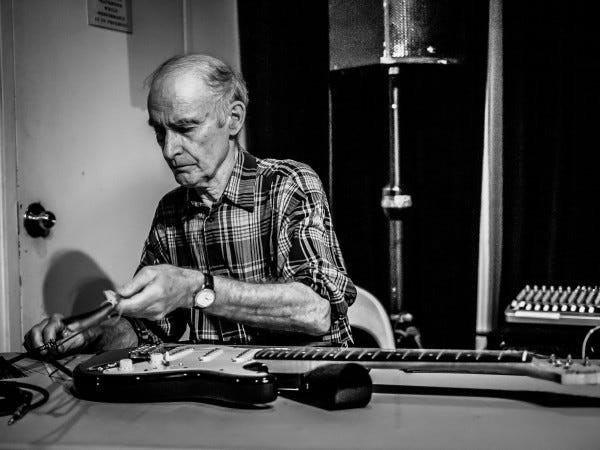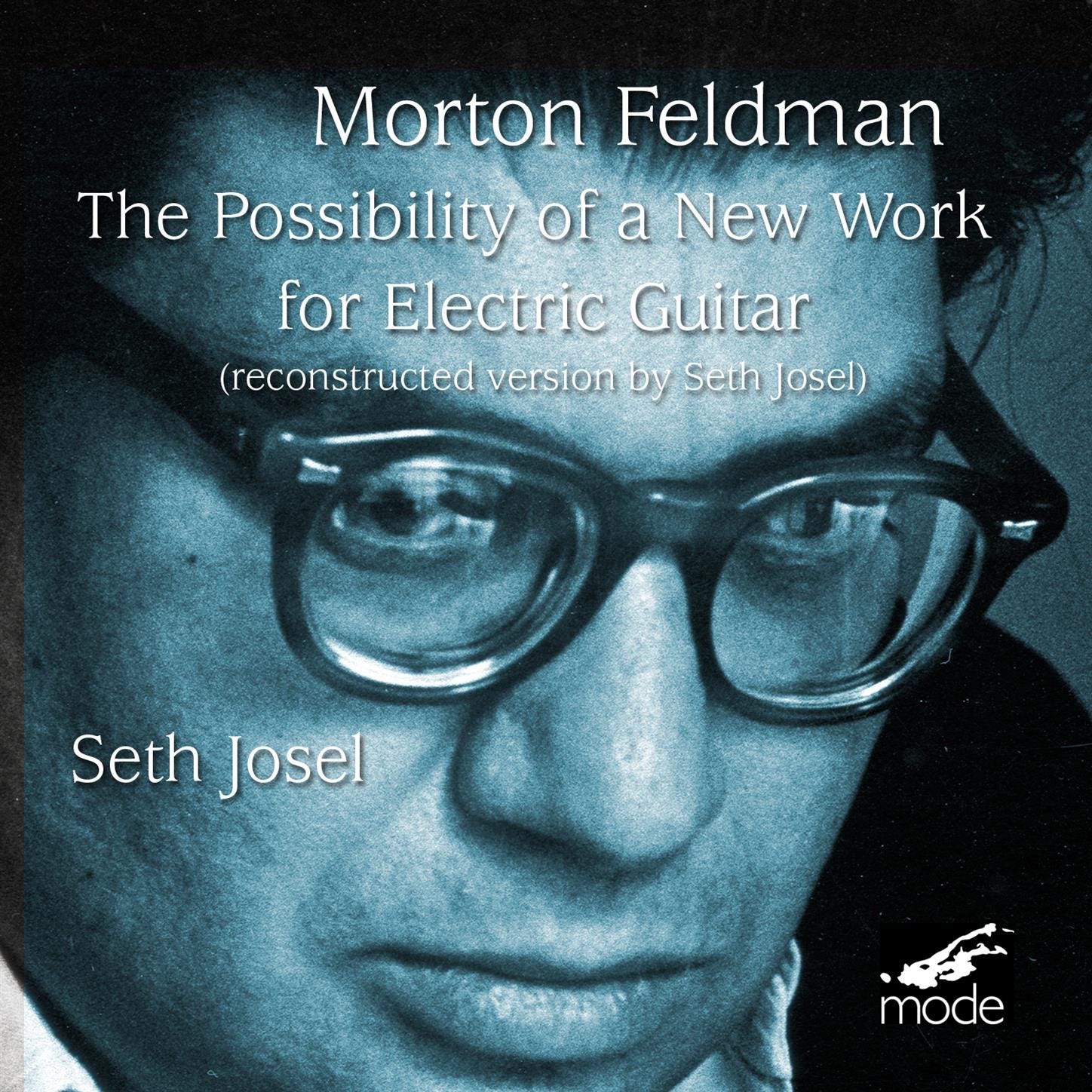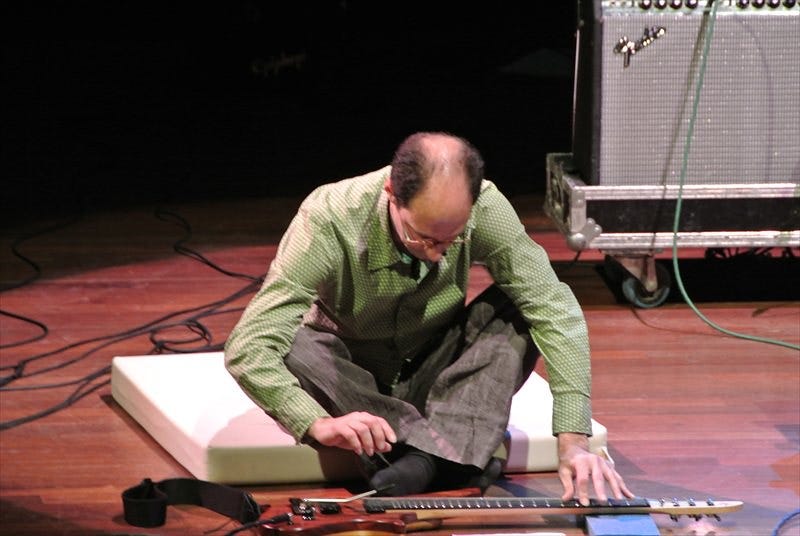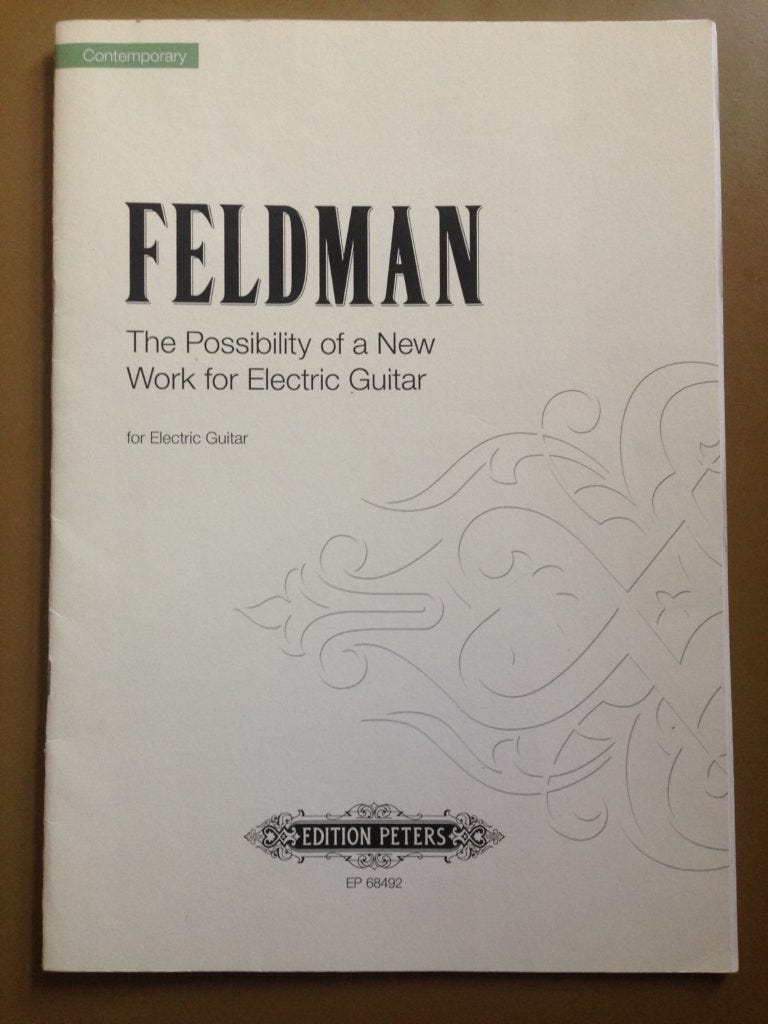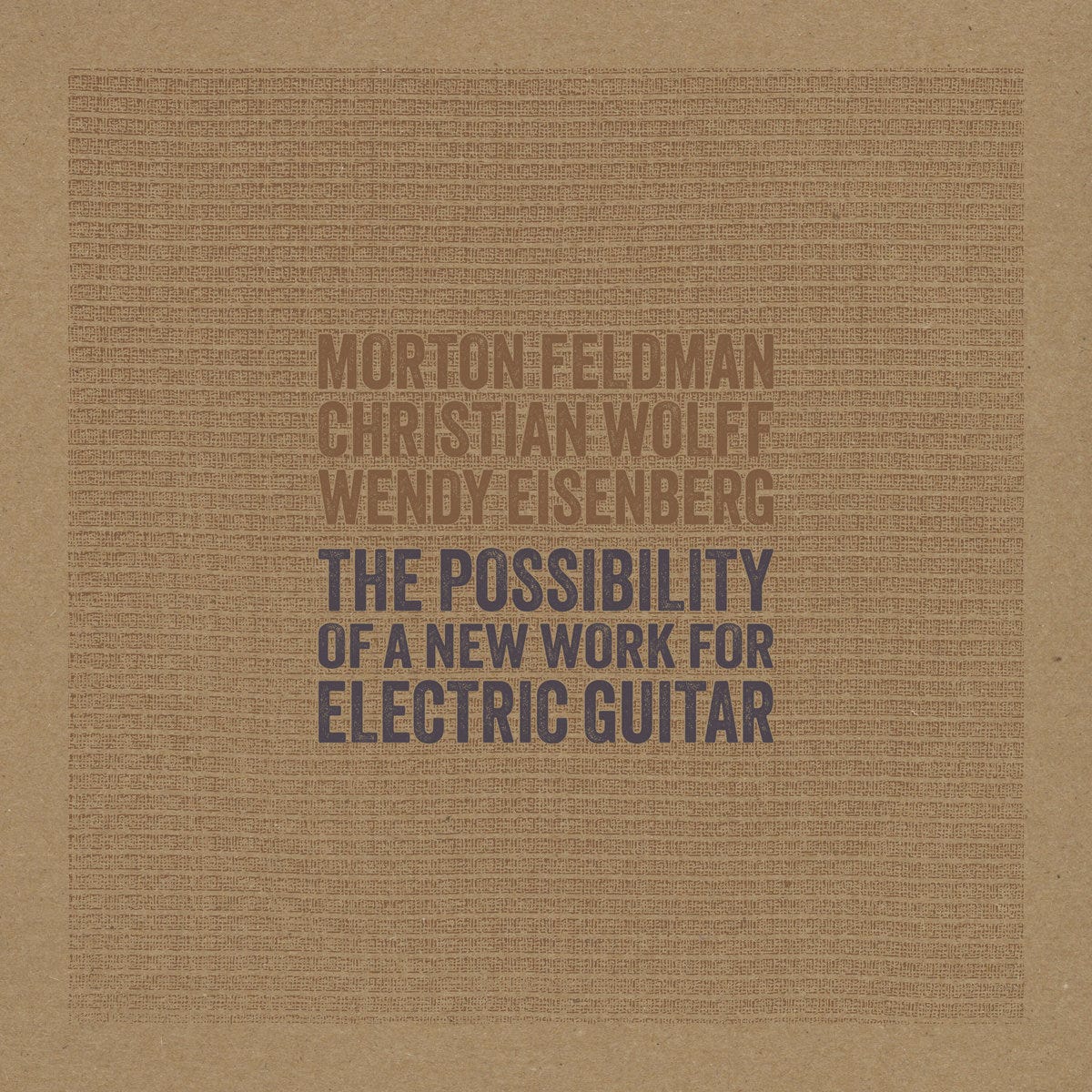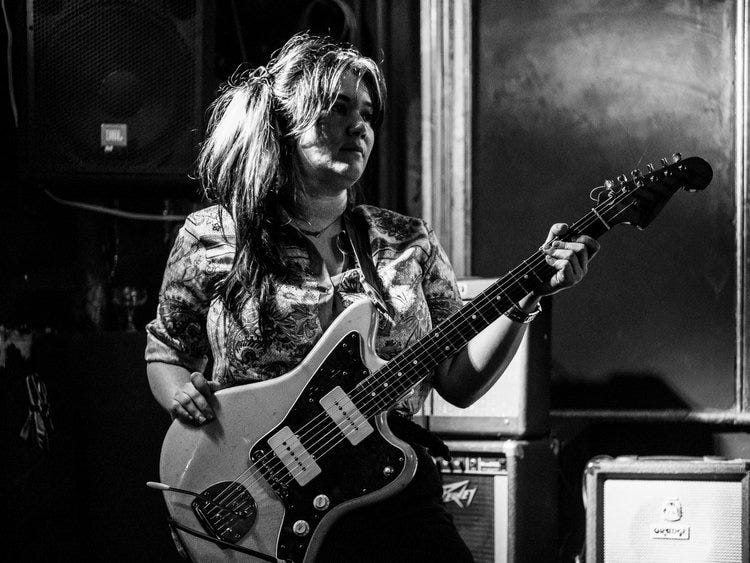Neuguitars 2025 #6 The Possibility of a New Work for Electric Guitar by Feldman/Wolff/Eisenberg. In a postmodern world, the possibilities remain endless.
Other Minds Records, 2024
Morton Feldman: Well, I wrote a piece for electric guitar, and I tried to overcome the fac of an electric guitar. And so Christian came over to the house and I had him try various things, very strange things and strange registers, and when it didn't sound like an electric guitar, I wrote it down. (laughs) I mean, it seemed too obvious just to write a piece for electric guitar. He plays it very beautifully, very hesitant.
Jon Cage: Merce Cunningham told me it was marvelously soft...
Cage/Feldman Radio happenings of 1966–67
https://archives.otherminds.org/index.php/MultiSearch/Index?search=john+cage+morton+feldman
Narratives are the cornerstones of this era, marked by intense economic, social, and artistic acceleration. Without a story, without a narrative, everything seems dull, tasteless, and meaningless—just a banal, inert form. Contemporary music is no exception. Unlike classical music, which benefits from the aura of a glorious past, or rock music, with its powerful kinetic impact, contemporary music is even more reliant on narrative to reach a wider audience.
This is the case with two musical scores touched by the aura of myth: The Possibility of a New Work for Electric Guitar (1966) by Morton Feldman and Another Possibility (2004) by Christian Wolff—two emblematic examples of this shared longing for storytelling. Their story deserves a thorough exploration, complete with a near Indiana Jones-style happy ending.
It all began when Morton Feldman composed The Possibility of a New Work for Electric Guitar in early 1966, at the request of his colleague Christian Wolff.
Wolff and Feldman were two of the most important American composers of the second half of the 20th century. Less well-known is the fact that, during that time, Christian Wolff also performed as an electric guitarist. Wolff played the instrument without any formal training, employing an idiosyncratic technique, often laying the guitar flat on the floor or a table.
The Possibility of a New Work for Electric Guitar appears to have emerged from one of those serendipitous moments during a meeting between the two composers to play music together. Feldman sat at the piano, producing sounds that Wolff attempted to translate to his guitar. Feldman documented the outcome of this exploratory process, and in doing so, the work began to take shape.
On the same occasion, Feldman handed the score to Wolff in a nearly complete form, although statements by both Feldman and Wolff from that time suggest that the work was not fully finished when Wolff received it. Feldman composed this music to be performed at a concert in New York, likely without the intention of it becoming a finalized piece or being published.
At that time, the electric guitar was still a rare instrument in classical and contemporary music, let alone the possibility of a solo piece. It is therefore understandable that Feldman might not have seriously considered how a solo work for electric guitar could achieve potential distribution. Christian Wolff performed The Possibility of a New Work for Electric Guitar on three separate occasions: at the Library and Museum of the Performing Arts in New York (July 1966), at the San Francisco Music Center (July 29, 1966), and at Harvard University, Cambridge (May 14, 1967).
Wolff kept the only copy of Feldman's score in the case of his guitar, which was tragically stolen, along with the manuscript, after the third performance. A fourth performance was planned at Yale but never took place. From that moment, The Possibility of a New Work for Electric Guitar became something of a legend in the realm of contemporary music for electric guitar—a true myth that seems to have finally been resolved through the reconstruction by guitarist Seth Josel, published by Edition Peters.
According to Peter Söderberg’s insightful essay, A musical work emerges and disappears – Morton Feldman’s The Possibility of a New Work for Electric Guitar, in the late 1990s, Norwegian guitarist and musicologist Jogrim Erland visited the Paul Sacher Foundation in Basel. This institution houses the Morton Feldman Collection, which includes most of the composer’s legacy. While studying Feldman’s orchestral music, Erland came across a single sheet of a sketch, which turned out to be connected to a forgotten work for electric guitar. Erland transcribed the sketch and returned to Cologne, where he was studying with guitarist Seth Josel. A copy of the transcription was handed to Josel, who embarked on a long-term project to trace Feldman’s lost work.
The surviving sketch page contained only three types of sonic material: broken chords, isolated low tones with a descending glissando (Wolff’s electric guitar was equipped with a vibrato arm), and an ascending melodic phrase. There were also scattered annotations on dynamics—a recurring crescendo to ppp—and an indication of which sound to play first. Among the noted sounds were numerous pauses, which seem to suggest that these were conceived as independent elements with no predetermined order. None of the sounds had a specified note value, leaving them free from any rhythmic determination.
Chris Villars, curator of the excellent site The Morton Feldman Page (now closed), took an interest in Christian Wolff's mention of a radio recording made during one of the performances of Feldman's electric guitar piece. According to Wolff, the recording had been made by the San Francisco radio station WKFA, but this turned out to be a false lead: no radio station by that name ever existed.
In 2006, the search led to Charles Amirkhanian and Other Minds, the organization that preserves the archive of recordings from KPFA radio station, based in Berkeley, California. It was discovered that a tape of the performance held in San Francisco in July 1966 had been archived on a shelf, though in very poor condition.
Although Seth Josel had initially determined that the single page of the sketch was insufficient to reconstruct the original lost score, the unexpected discovery of the recording became the basis for a possible reconstruction of the work. A project with this aim was initiated, promoted by Other Minds and entrusted to Seth Josel, who, as a guitarist specializing in contemporary music and an artistic researcher, was uniquely qualified for the task.
This work occupied Josel for a significant amount of time and led to a true revival of Feldman's composition. For several years now, there have been two alternative versions resulting from Josel's reconstruction, both included in an edition published in 2015 by Edition Peters.
One of the new scores is a straightforward transcription of the preserved recording. It consists of just five minutes of music, contained on a single page of the edition. Josel did not include dynamics—likely due to the poor quality of the recording—but otherwise, the notation bears a strong resemblance to Feldman's original sketch.
The other version is a reconstructed score based on Wolff’s recording, while also taking into account the sketch page. The latter shows some details that diverge from the recording, which can be explained in various ways. Were these perhaps mistakes by Wolff? After all, Wolff had a rudimentary guitar technique, which might have influenced the recording. However, Wolff was not reading the surviving sketch during his performances but rather the now-lost score, in which Feldman may have corrected the details of the sketch.
The Edition Peters publication also includes two informative texts shedding light on The Possibility of a New Work for Electric Guitar. Chris Villars describes the historical facts surrounding the creation of the piece, its rediscovery through the sketch and recording, while Seth Josel details his process in reconstructing the score.
Seth Josel performed Feldman’s reconstructed work for the first time in March 2009 at Yale University in New Haven. Interestingly, this is the same location where, 44 years earlier, Christian Wolff was headed when his car was broken into, leading to the theft of Feldman’s work. This long-awaited performance thus brought the piece full circle.
I think it felt like hearing the past return, embodied as a digitally restored ghost recording. A moment frozen in time, now brought back with a new presence.
It sounds like a happy ending, doesn’t it? But the story doesn’t end there. According to the liner notes written by Christian Wolff for the LP The Possibility of a New Work for Electric Guitar by Feldman/Wolff/Eisenberg, produced by Other Minds in 2024, in the late 1990s, Dutch guitarist Wiek Hijmans discovered a draft of a score titled Electric Guitar Piece in Feldman’s archives at the Sacher Foundation in Basel. Only a few notations matched the original piece. There is likely some confusion here with the details provided by Peter Söderberg. In any case, it seems Feldman had lost interest in the project and never used the electric guitar again. Hijmans asked Wolff to rewrite a new piece for electric guitar based on his recollections.
The result was Another Possibility (2004), a work for electric guitar with clear allusions to Feldman’s lost piece. To some extent, Wolff created a new composition while attempting to recreate the atmosphere of Feldman’s work, based on his personal recollection of the music he had performed so many years earlier, yet infused with his own distinctive style. Another Possibility is undoubtedly a completely new piece; when compared to Feldman’s reconstructed work, the differences are far more pronounced than any similarities.
Wolff has made several significant contributions to the development of the electric guitar’s role in concert music, having composed some of the earliest works to define the instrument’s character (his Electric Spring series from the 1960s) and many other notable pieces.
This piece showcases many of the hallmarks of Wolff’s work, particularly his esoteric use of musical notation, which seems designed to unbalance musicians, encouraging them to find their own approach to interpreting Wolff’s often ambiguous performance directions. The composer deliberately writes passages that appear impossible according to conventional notions of guitar technique, forcing the musician to discover new solutions for navigating chords and melodic lines. These devices help create an atmosphere of eccentricity and an almost childlike ingenuity and playfulness in exploring the instrument’s potential.
Christian Wolff has undoubtedly had a long, intimate, and fascinating musical relationship with the guitar, especially the electric guitar. He has played guitar, bass, and even a bit of banjo, collaborating with several guitarists, including Keith Rowe and Larry Polansky. Wolff seems to possess a profound understanding of what is both possible and imaginable for the electric instrument.
His music seems to rarely (thankfully) be "idiomatic." It rarely refers to, depends on, or even acknowledges guitar techniques, or anything else musically that the performer may have learned or be familiar with. I believe the hidden beauty in this piece lies in the fact that Wolff is a composer reluctant to provide signs of expression, articulation, dynamics, and so on in his scores, leaving performers with considerable freedom and risk. Over time, it has become a coveted piece for guitarists eager to expand their artistic boundaries and eager to engage with such "open" forms.
Now, however, this circle has come full circle: on March 1, 2024, Other Minds released a beautiful LP, The Possibility of a New Work for Electric Guitar by Feldman/Wolff/Eisenberg, where you can listen, in a sort of historical loop, to Wolff's original version of The Possibility of a New Work for Electric Guitar, the same piece performed by guitarist Wendy Eisenberg, recorded at Wind Tide, Littlefield, TX, on April 17, 2022, alongside Another Possibility by Christian Wolff.
Listening to this LP is truly fascinating.
This is not just about pure music or sound. The ghosts of time have shuffled their cards in this complex story, with such semiological connotations, allowing us to listen again to a piece of music once regarded as a legend and then as a myth of contemporary music, giving it a transfigured form. This LP is not just a collectible music item but something essential in the hands of every guitarist and contemporary music enthusiast. Here, music, research, archaeology, collecting, historical archiving, and, why not?, cultural fetishism come together.
Wendy Eisenberg plays all in the name of a new possibility for the electric guitar.
Bibliography
A musical work emerges and disappears – Morton Feldman’s The Possibility of a New Work for Electric Guitar by Peter Söderberg
Six strings, ten fingers and the heterophonic ideal: Some thoughts on Christian Wolff’s recent guitar music (pre-publication draft) by Larry Polansky Polansky.Wolff.Six_Strings (dartmouth.edu) Polansky.Wolff.Six_Strings (dartmouth.edu)
Insert of The Possibility of a New Work for Electric Guitar di Feldman/Wolff/Eisenberg, Other Minds Records OM 3004

